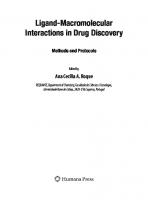Virus-Host Interactions: Methods and Protocols 1627036008, 9781627036009
Virus-Host Interactions: Methods and Protocols covers various aspects of virological research, such as biochemical appro
336 43 3KB
English Pages 384 [371] Year 2013
Table of contents :
Preface......Page 6
Contents......Page 8
Contributors......Page 10
1 Introduction......Page 12
2.2 Media and Stock Solutions......Page 16
2.3 Equipment and Consumables......Page 17
3.1 Array-Based Yeast Two-Hybrid Screening......Page 18
3.2 Library-Based Yeast Two-Hybrid Screening......Page 20
4 Notes......Page 24
References......Page 25
1 Introduction......Page 27
2.3 Stock Solutions......Page 32
2.7 Plastic Ware......Page 34
3.2 Cell Lysis, Washing and Measurement......Page 35
4 Notes......Page 36
References......Page 37
1 Introduction......Page 38
2.1 Generation of Recombinant Viruses......Page 42
2.3 Cells and Cell Culture......Page 43
3.1 Transfection of MRC-5 with Inducible Expression Plasmids (Day 1)......Page 44
3.3 Induction of the Inducible Expression Plasmid (Day 6)......Page 45
3.5 Quantification of BiFC Efficiency......Page 46
4 Notes......Page 47
References......Page 49
1 Introduction......Page 51
2.2.3 Cryogenic Disruption of the Cell Pellets......Page 57
2.4.1 Immunoaffinity Purification of Protein Complexes......Page 58
3.1 Epitope Selection......Page 59
3.2 Selection, Preparation, and Lysis of Infected Cells......Page 61
3.2.2 Freezing Cell Pellet......Page 62
3.2.3 Cryogenic Disruption of Cell Pellets......Page 63
3.2.5 Alternative Cryogenic Grinding- Smaller Sample Size ......Page 64
3.3 Antibody Conjugation......Page 65
3.4.1 Immunoaffinity Purification of Protein Complexes......Page 67
3.4.2 Assessing the Efficiency of Immunoaffinity Purification......Page 70
Optimization Following the Immunoaffinity Purification......Page 71
3.5 Selecting Controls......Page 72
3.5.2 Controlling for Nonspecific Associations to the Isolated Protein Complex of Interest......Page 73
4 Notes......Page 74
References......Page 77
1 Introduction......Page 79
2.1 siRNA Library Resuspension and Assay Plate Preparation......Page 81
2.2 Cell Culture, Transfection and Infection......Page 83
3 Methods......Page 84
3.2 Preparation of 96-Well and 384-Well Master Plates......Page 85
3.3 Assay Plate Preparation......Page 87
3.4 Preparation of Cells for siRNA Transfection......Page 88
3.5 siRNA Transfection......Page 89
3.7 Phenotypic Assay 2: HSV-1 Replication Assay......Page 90
3.8 Data Analysis and Identification of Antiviral and Proviral Cellular Factors......Page 91
4 Notes......Page 92
References......Page 97
1 Introduction......Page 99
2.1 Metabolic Labeling and Isolation of Total Cellular RNA......Page 101
3.1 Metabolic Labeling of Newly Transcribed RNA with 4-Thiouridine......Page 102
3.2 RNA Preparation Using Modified Trizol Protocol......Page 103
3.3.1 Labeling Reaction......Page 104
3.5 Recovery of Newly Transcribed RNA......Page 105
4 Notes......Page 106
References......Page 107
1 Introduction......Page 109
2.1 Components for Homogenization and Fractionation......Page 112
2.3 Components for Western Blotting......Page 113
3.2 Infection......Page 114
3.5 Analysis of Gradient Fractions for Endosomal, Cytoplasmic, and Nuclear Markers by Immunoblotting......Page 115
3.6 Analysis of Endosomal Fractions by Quantitative Mass Spectrometry......Page 116
3.7 Analysis of Endosomal Escape by Western Blotting and Quantitative Real-Time PCR......Page 117
4 Notes......Page 118
References......Page 120
1 Introduction......Page 122
2 Resources and Databases......Page 124
3 Virus–Host Interactions in the Context of the Cellular Interactome......Page 125
4 Evaluation of Targeted Pathways and Biological Processes......Page 127
5 Identification of Novel Functional Modules Involved in Virus Infection......Page 130
6 Prediction of Virus–Host Interactions......Page 133
References......Page 135
1 Introduction......Page 138
2 Materials......Page 141
3.1 Preparation of COS-7 Cells......Page 142
3.4 Formation of Heterokaryons......Page 143
3.5 Interspecies Heterokaryon Assay in the Context of Infection......Page 144
4 Notes......Page 145
References......Page 146
1 Introduction......Page 148
2.3 Fluorescence In Situ Hybridization......Page 151
3.1 Preparation of Cells......Page 152
3.3 Preparation of FISH Probes (Random Priming)......Page 153
3.5 Wash and Detection......Page 154
4 Notes......Page 155
References......Page 158
1 Introduction......Page 160
2.1 Cell Culture......Page 165
3.1 Generation of a Stable U-2 OS FRT Cell Line......Page 166
3.3 Selection of Stable, FRT Containing Cell Clones......Page 167
3.5 Utilizing the Gateway™ System to Generate FP Tagged Fusion Proteins......Page 168
3.6 Modification of pEF5/FRT/V5-DEST to Express FP-Fusions......Page 169
3.7 Transferring a cDNA into the Gateway™ System......Page 171
3.9 Generation of Flp-In™ Compatible Expression Vectors Coding for Peptide- Tagged FPs......Page 172
3.11 Generation of Stable Cell Lines ......Page 173
4 Notes......Page 174
References......Page 176
1 Introduction......Page 177
2.3 Seeding and Infection of MV9G Cells......Page 179
3.1 Plaque Assay to Determine Titer of Virus Stock......Page 180
3.2 Luciferase Assay to Determine Infectivity of Virus......Page 182
4 Notes......Page 184
References......Page 187
1 Introduction......Page 188
2.1 Cloning......Page 190
2.2 Lentivirus Production......Page 191
3.1 Cloning of a miRNA Precursor into the Lentiviral Vector......Page 192
3.2 Production of Lentivirus......Page 195
3.3 Determination of Antibiotic Sensitivity of Target Cells......Page 196
3.4 Transduction of the Cell Line of Interest......Page 197
3.5 Isolation of Individual Clones by Limiting Dilution......Page 198
4 Notes......Page 200
References......Page 204
1 Introduction......Page 206
2.1 Live Cell Imaging......Page 207
3.1 Preparation of Virus Suspension......Page 208
3.3 Generation of Fixed-Images at Different Time Points of Infection......Page 209
4 Notes......Page 212
References......Page 214
1 Introduction......Page 215
2.4 Microscopy: Hardware Setup......Page 217
3.1 Virus Labeling Protocol......Page 218
3.3 Viral Infectivity of Labeled Virus Determined by Plaque-Forming Assays......Page 219
3.4 Viral Infectivity of Labeled Virus Determined by Fluorescence Activated Cell Sorting......Page 220
3.5 Imaging: Infection Without Pre-binding......Page 221
3.6 Imaging: Infection with Pre-binding......Page 223
3.7 Imaging: General Remarks......Page 225
3.8 Controls......Page 226
4 Notes......Page 227
References......Page 230
1 Introduction......Page 231
2.1 Serial Sectioning......Page 232
3 Methods......Page 233
3.1 Serial Sectioning......Page 234
3.2 Image Acquisition......Page 235
3.4 De-warping of Distorted Images......Page 236
4 Notes......Page 238
References......Page 240
1 Introduction......Page 242
2.1 Virus and Cell Lines......Page 243
2.2 Cell Culture Media and Components......Page 244
3 Methods......Page 245
3.1 Generation of a Quiescently HSV-1 Infected Neuronal Cell Line......Page 246
3.2 Generation of a 3D HSV-1 Infection Model......Page 247
3.3 In Vitro Reactivation of Quiescently Infected HSV-1......Page 248
4 Notes......Page 250
References......Page 253
1 Introduction......Page 255
2.1 Production of High Titer Virus Stock......Page 256
2.3 MRI Hardware......Page 257
2.4 Animal Handling......Page 258
3.1 Infection of BHK Cells......Page 259
3.3 General Anesthesia and Infection of the C57BL/6N Mouse......Page 260
3.4 Animal Preparation and Handling for MRI Scanning......Page 261
3.5 MR Imaging......Page 262
4 Notes......Page 263
References......Page 266
1 Introduction......Page 268
2.1 Buffers and Solutions......Page 269
2.2 Antigens and Antibodies......Page 270
3.2 Fixation Reaction......Page 271
3.4 Analysis of the Cells in the Flow-Cytometer......Page 272
4 Notes......Page 274
References......Page 275
1 Introduction......Page 276
3 Methods......Page 279
3.2 Prepare Peripheral Blood Mononuclear Cells (PBMC)......Page 280
3.4 51 Cr Release Assay......Page 281
3.5 7-AAD Assay......Page 283
4 Notes......Page 285
References......Page 287
1 Introduction......Page 289
2.1 Preparation and Cryopreservation of Peripheral Blood Mononuclear Cells......Page 290
2.4 Negative Selection of NK Cells from Cryopreserved PBMCs and Coculture of Effector and Target Cells......Page 291
3.2 Isolation of Monocytes and Polarization of Macrophages......Page 292
3.4 Negative Selection of NK Cells from Cryopreserved PBMCs and Coculture of Effector and Target Cells......Page 293
3.5 Flow Cytometry- Based Assay for Measuring NK Cell Responses ......Page 294
4 Notes......Page 296
References......Page 297
1 Introduction......Page 299
2 Materials......Page 300
2.2 Virus and Solution for Virus Stocks......Page 301
2.5 Actin Polymerization Reagents......Page 302
2.7 Equipments......Page 303
3.2 Preparation of Virus Stocks......Page 304
3.4 Cell Polarization Assays......Page 305
3.5 Assessment of Actin Polymerization......Page 306
3.6 Cell Migration Assays......Page 307
4 Notes......Page 309
References......Page 312
1 The Application of Genetically Modified Mice for the Study of Viral Pathogenesis and Antiviral Immunity......Page 314
3 Generation of Mutant Mice from Genetically Modified Embryonic Stem Cells......Page 316
4 Gene Targeting in ESCs......Page 320
5 The Use of Cre/loxP Recombination System in Gene Targeting......Page 323
6 Cloning of the Targeting Vector......Page 325
7 Targeting Transgenes into the ROSA26 Locus......Page 326
8 Considerations for the Type of Genetic Modification......Page 327
9 Considerations for the Type of Reporter Genes When Generating Reporter Mice......Page 328
References......Page 330
1 Introduction......Page 336
2.1 Cloning of the Targeting Vector......Page 337
2.5 Electroporation of ESCs with the Targeting Vector......Page 338
2.8 Screening by Southern Blot Analysis for ESC Clones with Homologous Recombination of the Targeting Vector......Page 339
3.1 Cloning of the Targeting Vector......Page 340
3.2 Proposed Strategy to Generate Targeting Vectors Using MultiSite Gateway Cloning (in Combination with Restriction Enzymes/Sites)......Page 343
3.3 Isolation, Culture, and Mitotic Inactivation of Mouse Embryonic Fibroblasts (MEFs)......Page 345
3.4 Culture of ESCs......Page 346
3.5.2 Electroporation of ESCs......Page 347
3.6 Selection and Picking of Positively Transfected ESC Clones......Page 348
3.8 Screening for ESC Clones with Homologous Recombination of the Targeting Vector by Southern Blot Analysis......Page 349
3.9 Generation of Chimeric Mice from Genetically Modified ESC Clones......Page 350
4 Notes......Page 351
References......Page 353
1 Introduction......Page 354
2.2 Preparation of Lentiviruses in HEK 293T Cells......Page 355
3 Methods......Page 356
3.2 Production of SV40 Large T Antigen Expressing Lentivirus in 293T Cells......Page 357
3.4 Cell Maintenance......Page 359
3.7 Luciferase Assay with Cell Lysates......Page 360
3.8 Luciferase Assay in Living Cells......Page 362
4 Notes......Page 363
References......Page 365
Index......Page 366
Preface......Page 6
Contents......Page 8
Contributors......Page 10
1 Introduction......Page 12
2.2 Media and Stock Solutions......Page 16
2.3 Equipment and Consumables......Page 17
3.1 Array-Based Yeast Two-Hybrid Screening......Page 18
3.2 Library-Based Yeast Two-Hybrid Screening......Page 20
4 Notes......Page 24
References......Page 25
1 Introduction......Page 27
2.3 Stock Solutions......Page 32
2.7 Plastic Ware......Page 34
3.2 Cell Lysis, Washing and Measurement......Page 35
4 Notes......Page 36
References......Page 37
1 Introduction......Page 38
2.1 Generation of Recombinant Viruses......Page 42
2.3 Cells and Cell Culture......Page 43
3.1 Transfection of MRC-5 with Inducible Expression Plasmids (Day 1)......Page 44
3.3 Induction of the Inducible Expression Plasmid (Day 6)......Page 45
3.5 Quantification of BiFC Efficiency......Page 46
4 Notes......Page 47
References......Page 49
1 Introduction......Page 51
2.2.3 Cryogenic Disruption of the Cell Pellets......Page 57
2.4.1 Immunoaffinity Purification of Protein Complexes......Page 58
3.1 Epitope Selection......Page 59
3.2 Selection, Preparation, and Lysis of Infected Cells......Page 61
3.2.2 Freezing Cell Pellet......Page 62
3.2.3 Cryogenic Disruption of Cell Pellets......Page 63
3.2.5 Alternative Cryogenic Grinding- Smaller Sample Size ......Page 64
3.3 Antibody Conjugation......Page 65
3.4.1 Immunoaffinity Purification of Protein Complexes......Page 67
3.4.2 Assessing the Efficiency of Immunoaffinity Purification......Page 70
Optimization Following the Immunoaffinity Purification......Page 71
3.5 Selecting Controls......Page 72
3.5.2 Controlling for Nonspecific Associations to the Isolated Protein Complex of Interest......Page 73
4 Notes......Page 74
References......Page 77
1 Introduction......Page 79
2.1 siRNA Library Resuspension and Assay Plate Preparation......Page 81
2.2 Cell Culture, Transfection and Infection......Page 83
3 Methods......Page 84
3.2 Preparation of 96-Well and 384-Well Master Plates......Page 85
3.3 Assay Plate Preparation......Page 87
3.4 Preparation of Cells for siRNA Transfection......Page 88
3.5 siRNA Transfection......Page 89
3.7 Phenotypic Assay 2: HSV-1 Replication Assay......Page 90
3.8 Data Analysis and Identification of Antiviral and Proviral Cellular Factors......Page 91
4 Notes......Page 92
References......Page 97
1 Introduction......Page 99
2.1 Metabolic Labeling and Isolation of Total Cellular RNA......Page 101
3.1 Metabolic Labeling of Newly Transcribed RNA with 4-Thiouridine......Page 102
3.2 RNA Preparation Using Modified Trizol Protocol......Page 103
3.3.1 Labeling Reaction......Page 104
3.5 Recovery of Newly Transcribed RNA......Page 105
4 Notes......Page 106
References......Page 107
1 Introduction......Page 109
2.1 Components for Homogenization and Fractionation......Page 112
2.3 Components for Western Blotting......Page 113
3.2 Infection......Page 114
3.5 Analysis of Gradient Fractions for Endosomal, Cytoplasmic, and Nuclear Markers by Immunoblotting......Page 115
3.6 Analysis of Endosomal Fractions by Quantitative Mass Spectrometry......Page 116
3.7 Analysis of Endosomal Escape by Western Blotting and Quantitative Real-Time PCR......Page 117
4 Notes......Page 118
References......Page 120
1 Introduction......Page 122
2 Resources and Databases......Page 124
3 Virus–Host Interactions in the Context of the Cellular Interactome......Page 125
4 Evaluation of Targeted Pathways and Biological Processes......Page 127
5 Identification of Novel Functional Modules Involved in Virus Infection......Page 130
6 Prediction of Virus–Host Interactions......Page 133
References......Page 135
1 Introduction......Page 138
2 Materials......Page 141
3.1 Preparation of COS-7 Cells......Page 142
3.4 Formation of Heterokaryons......Page 143
3.5 Interspecies Heterokaryon Assay in the Context of Infection......Page 144
4 Notes......Page 145
References......Page 146
1 Introduction......Page 148
2.3 Fluorescence In Situ Hybridization......Page 151
3.1 Preparation of Cells......Page 152
3.3 Preparation of FISH Probes (Random Priming)......Page 153
3.5 Wash and Detection......Page 154
4 Notes......Page 155
References......Page 158
1 Introduction......Page 160
2.1 Cell Culture......Page 165
3.1 Generation of a Stable U-2 OS FRT Cell Line......Page 166
3.3 Selection of Stable, FRT Containing Cell Clones......Page 167
3.5 Utilizing the Gateway™ System to Generate FP Tagged Fusion Proteins......Page 168
3.6 Modification of pEF5/FRT/V5-DEST to Express FP-Fusions......Page 169
3.7 Transferring a cDNA into the Gateway™ System......Page 171
3.9 Generation of Flp-In™ Compatible Expression Vectors Coding for Peptide- Tagged FPs......Page 172
3.11 Generation of Stable Cell Lines ......Page 173
4 Notes......Page 174
References......Page 176
1 Introduction......Page 177
2.3 Seeding and Infection of MV9G Cells......Page 179
3.1 Plaque Assay to Determine Titer of Virus Stock......Page 180
3.2 Luciferase Assay to Determine Infectivity of Virus......Page 182
4 Notes......Page 184
References......Page 187
1 Introduction......Page 188
2.1 Cloning......Page 190
2.2 Lentivirus Production......Page 191
3.1 Cloning of a miRNA Precursor into the Lentiviral Vector......Page 192
3.2 Production of Lentivirus......Page 195
3.3 Determination of Antibiotic Sensitivity of Target Cells......Page 196
3.4 Transduction of the Cell Line of Interest......Page 197
3.5 Isolation of Individual Clones by Limiting Dilution......Page 198
4 Notes......Page 200
References......Page 204
1 Introduction......Page 206
2.1 Live Cell Imaging......Page 207
3.1 Preparation of Virus Suspension......Page 208
3.3 Generation of Fixed-Images at Different Time Points of Infection......Page 209
4 Notes......Page 212
References......Page 214
1 Introduction......Page 215
2.4 Microscopy: Hardware Setup......Page 217
3.1 Virus Labeling Protocol......Page 218
3.3 Viral Infectivity of Labeled Virus Determined by Plaque-Forming Assays......Page 219
3.4 Viral Infectivity of Labeled Virus Determined by Fluorescence Activated Cell Sorting......Page 220
3.5 Imaging: Infection Without Pre-binding......Page 221
3.6 Imaging: Infection with Pre-binding......Page 223
3.7 Imaging: General Remarks......Page 225
3.8 Controls......Page 226
4 Notes......Page 227
References......Page 230
1 Introduction......Page 231
2.1 Serial Sectioning......Page 232
3 Methods......Page 233
3.1 Serial Sectioning......Page 234
3.2 Image Acquisition......Page 235
3.4 De-warping of Distorted Images......Page 236
4 Notes......Page 238
References......Page 240
1 Introduction......Page 242
2.1 Virus and Cell Lines......Page 243
2.2 Cell Culture Media and Components......Page 244
3 Methods......Page 245
3.1 Generation of a Quiescently HSV-1 Infected Neuronal Cell Line......Page 246
3.2 Generation of a 3D HSV-1 Infection Model......Page 247
3.3 In Vitro Reactivation of Quiescently Infected HSV-1......Page 248
4 Notes......Page 250
References......Page 253
1 Introduction......Page 255
2.1 Production of High Titer Virus Stock......Page 256
2.3 MRI Hardware......Page 257
2.4 Animal Handling......Page 258
3.1 Infection of BHK Cells......Page 259
3.3 General Anesthesia and Infection of the C57BL/6N Mouse......Page 260
3.4 Animal Preparation and Handling for MRI Scanning......Page 261
3.5 MR Imaging......Page 262
4 Notes......Page 263
References......Page 266
1 Introduction......Page 268
2.1 Buffers and Solutions......Page 269
2.2 Antigens and Antibodies......Page 270
3.2 Fixation Reaction......Page 271
3.4 Analysis of the Cells in the Flow-Cytometer......Page 272
4 Notes......Page 274
References......Page 275
1 Introduction......Page 276
3 Methods......Page 279
3.2 Prepare Peripheral Blood Mononuclear Cells (PBMC)......Page 280
3.4 51 Cr Release Assay......Page 281
3.5 7-AAD Assay......Page 283
4 Notes......Page 285
References......Page 287
1 Introduction......Page 289
2.1 Preparation and Cryopreservation of Peripheral Blood Mononuclear Cells......Page 290
2.4 Negative Selection of NK Cells from Cryopreserved PBMCs and Coculture of Effector and Target Cells......Page 291
3.2 Isolation of Monocytes and Polarization of Macrophages......Page 292
3.4 Negative Selection of NK Cells from Cryopreserved PBMCs and Coculture of Effector and Target Cells......Page 293
3.5 Flow Cytometry- Based Assay for Measuring NK Cell Responses ......Page 294
4 Notes......Page 296
References......Page 297
1 Introduction......Page 299
2 Materials......Page 300
2.2 Virus and Solution for Virus Stocks......Page 301
2.5 Actin Polymerization Reagents......Page 302
2.7 Equipments......Page 303
3.2 Preparation of Virus Stocks......Page 304
3.4 Cell Polarization Assays......Page 305
3.5 Assessment of Actin Polymerization......Page 306
3.6 Cell Migration Assays......Page 307
4 Notes......Page 309
References......Page 312
1 The Application of Genetically Modified Mice for the Study of Viral Pathogenesis and Antiviral Immunity......Page 314
3 Generation of Mutant Mice from Genetically Modified Embryonic Stem Cells......Page 316
4 Gene Targeting in ESCs......Page 320
5 The Use of Cre/loxP Recombination System in Gene Targeting......Page 323
6 Cloning of the Targeting Vector......Page 325
7 Targeting Transgenes into the ROSA26 Locus......Page 326
8 Considerations for the Type of Genetic Modification......Page 327
9 Considerations for the Type of Reporter Genes When Generating Reporter Mice......Page 328
References......Page 330
1 Introduction......Page 336
2.1 Cloning of the Targeting Vector......Page 337
2.5 Electroporation of ESCs with the Targeting Vector......Page 338
2.8 Screening by Southern Blot Analysis for ESC Clones with Homologous Recombination of the Targeting Vector......Page 339
3.1 Cloning of the Targeting Vector......Page 340
3.2 Proposed Strategy to Generate Targeting Vectors Using MultiSite Gateway Cloning (in Combination with Restriction Enzymes/Sites)......Page 343
3.3 Isolation, Culture, and Mitotic Inactivation of Mouse Embryonic Fibroblasts (MEFs)......Page 345
3.4 Culture of ESCs......Page 346
3.5.2 Electroporation of ESCs......Page 347
3.6 Selection and Picking of Positively Transfected ESC Clones......Page 348
3.8 Screening for ESC Clones with Homologous Recombination of the Targeting Vector by Southern Blot Analysis......Page 349
3.9 Generation of Chimeric Mice from Genetically Modified ESC Clones......Page 350
4 Notes......Page 351
References......Page 353
1 Introduction......Page 354
2.2 Preparation of Lentiviruses in HEK 293T Cells......Page 355
3 Methods......Page 356
3.2 Production of SV40 Large T Antigen Expressing Lentivirus in 293T Cells......Page 357
3.4 Cell Maintenance......Page 359
3.7 Luciferase Assay with Cell Lysates......Page 360
3.8 Luciferase Assay in Living Cells......Page 362
4 Notes......Page 363
References......Page 365
Index......Page 366

- Author / Uploaded
- Susanne M. Bailer
- Diana Lieber

![RNA-Chromatin Interactions: Methods and Protocols [1st ed.]
9781071606797, 9781071606803](https://ebin.pub/img/200x200/rna-chromatin-interactions-methods-and-protocols-1st-ed-9781071606797-9781071606803.jpg)






